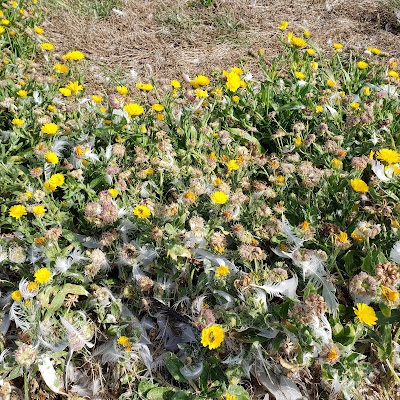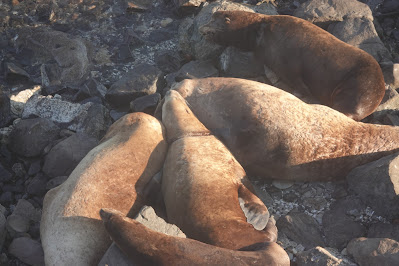A very pretty red and white bird visited Race Rocks today, but it's not going to be entered on my eBird list. In response to the issue with the fog horn, Coast Guard personnel arrived this morning in a helicopter. Most of the young gulls on the island are now at least partially flighted, so I was less concerned about a landing than I was a couple of weeks ago when they requested information on whether it was safe to do so. Now that the fog horn was malfunctioning, there wasn't much of a choice.
 |
| Coast Guard Helicopter arriving with crew to check foghorn issue. |
As expected, most of the adult and several of the young Glaucous-winged Gulls in the vicinity of the helipad took off as the helicopter arrived, but they weren't the first to leave. Many of the California Gulls on the outlying islets took to the air well before the chopper got close circling around and then returning to their spots, much as they do when an eagle passes by. The marine mammals on the outlying islets and on the point west of the Science Building took little notice of the action on Great Race.
 |
| Birds responded much as they would to a predator such as an eagle. |
 |
| Young gulls were definitely in the mix. |
 |
| The marine mammals remaind nonchalant about the whole thing. |
What did surprise me was the action of the young, still flightless gulls. As if in response to a predator, they bunched up into a loose creche. Normally, they will still to their own territories as wandering into a neighbours will result in an attack by an adult, but with many of the parents temporarily gone, they bunched up. Even the remaining adults were tolerant and didn't attack the young that had wandered into their territories--the first time.
 |
| Young gulls grouped up in response to the intruder. |
The helicopter actually landed twice: once to drop of the crew and once to pick them up. The second time, it came in from a different direction, causing the birds west of the heliport to react, but many of the adults from the east stayed put and exhibited more "normal" behaviour, i.e., attacking young that wandered too close. After each landing, it took only a matter of seconds before the gulls started resuming their normal activities, even with the helicopter on the pad. They reacted very little to the take off, and within a couple of minutes, you wouldn't even know that anything unusual had happened. The wind produced by the helicopter was much less than we get here most days. A visual check from a short distance did not reveal any injured birds.
 |
| Back to normal within seconds |
I couldn't be everywhere at once, but I went to the jetty to assess the response by the marine mammals there. When I arrived about two minutes after the second take off, there were no Steller's sea lions in the immediate area, but I could see them on the rocks a short distance away. Within 5 minutes, they were bumping the California sea lions, which had largely stayed put, out of their favourite spots.
After the first landing, I returned to my solar panel cleaning and can report that there was no extra fouling done due to the disruption. All I found was a small clump of dried grass that was probably dropped by a fleeing gull.
 |
| The only deposit resulting from the first landing |
The crew found no problem with the detection system or the fog horn but will be checking the data from the battery file to see if they can determine the cause of the failure.
 |
| I'm not the only one to have to wash solar panels! |
Wednesday is census day, and since I didn't know how disruptive the Coast Guard visit would be, I got most of it done early. Fortunately, that also coincided with low tide, which is the best time to count the sea lions and seals. I was all set to go up the tower to survey the mammals when the fog rolled in, but fortunately it subsided within about 10 minutes and I was good to go. Since the wind was low, I could actually go outside the lamphouse to see them without the interference of glass. With the numbers of sea lions increasing, it is easier to count them from above--sort of. Look at this mass of marine mammal flesh! It is literally hard to make heads or tails out of them.
 |
| 1,2, 3, 4, 5, 6, 7, oh crap... 1, 2, 3, 4, shoot!, 1, 2, 3, 4, 5, 6, 7, 8, sigh... |
You get outside by scrunching or crawling through this tiny door. Once outside, it's clear that the railings that were acceptable by 1860 standards, when the lighthouse was built would not be acceptable today. I'm not afraid of heights, but I'm afraid of my own negligence, so I stepped very carefully and held onto something every time I moved. If you slipped, you definitely could fall through the railing. With my clicker blazing, I clicked all the animals I could see and took photos for a review later.
 |
| This door is about 2 feet high |
 |
| Very wide openings in the railings! |
The rest of census is completed throughout the day, as different species are at their peaks at different times. The Pigeon Guillemots are almost absent now. I suspect most, if not all, of the young have fledged, and they are likely safer away from the gulls. Shorebird numbers in the East Bay peak in the early evening, and my numbers are likely under the actual total as they have had to move to make room for the sea lions, and can't all be seen as they were in previous weeks. A Common Raven flew over, adding a new species to my list for the island. And of course, I was able to find a Brown-headed Cowbird.
Here is today's census list:
Mammals
- Elephant seal: 1 (1 adult male)
- Steller sea lion: 210 (including branded (882R, 998E, 431Y, and 486Y)
- California sea lion: 343 (including branded V27)
- Harbour seal: 237
- Sea Otter: 1
- Harbour porpoise: 14 (to the west of the reserve)
Birds
- Black oystercatcher: 5 (4 adults 1 chick )
- Killdeer 1
- Black Turnstone: 85
- Surfbird: 10
- Common Murre: 300, plus another 550 beyond the reserve
- Pigeon Guillemot: 28
- Rhinoceros Auklet: 8
- Heermann’s Gull: 2
- California Gulls: 800, plus another 500 beyond the reserve
- Glaucous-winged Gulls: 343 adults 141 chicks
- Pelagic Cormorant: 1
- Brandt’s Cormorant: 11
- Common Raven: 1
- Brown-headed Cowbird: 1
Bubbles was unperturbed by the helicopter, but headed down to the water between landings. He is in serious molt right now and appears to be very itchy. Marine mammal molt looks like a very uncomfortable activity, and I'm sure that the cool water was quite soothing. The outer layer of skin and fur peels away in lumps and patches, and can take several weeks. Last year, he was finishing up when I was here. It looks like he is about three weeks behind schedule this year, like so many other things.
 |
| Bubbles's bath |
 |
| Fur and skin sloughing off |
 |
| Itchy! |
 |
| It's almost like having a bad sunburn. |
Tomorrow will be my last full day as a relief ecoguardian. I suspect much of it will be spent cleaning up and doing some last minute things. I think a group of students will be here as well, but I'm not sure how much interaction I will have with them.
Mushu update:
 |
| Someone wasn't home to move the mattress pads around. Mushu had to sit on the floor to get his sun. |
He doesn't know he's headed home in a couple of days. Back to the land of carpet!
Here are some more shots from today including several branded sea lions:
 |
| Ollie! |
 |
| Wasted no time in undoing my work! |
 |
| Brown-headed Cowbird |
 |
| It's so chilly, you can see my breath! |












































































